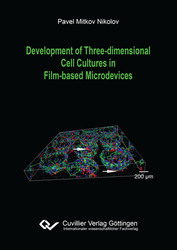| Areas | |
|---|---|
| Serie de libros (96) |
1378
|
| Nachhaltigkeit |
3
|
| Gesundheitswesen |
1
|
| Letra |
2364
|
| Ciencias Naturales |
5406
|
| Matemática | 229 |
| Informática | 319 |
| Física | 980 |
| Química | 1363 |
| Geociencias | 131 |
| Medicina humana | 243 |
| Estomatología | 10 |
| Veterinaria | 108 |
| Farmacia | 147 |
| Biología | 835 |
| Bioquímica, biología molecular, tecnología genética | 121 |
| Biofísica | 25 |
| Nutrición | 45 |
| Agricultura | 1004 |
| Silvicultura | 201 |
| Horticultura | 20 |
| Ecología y conservación de la tierra | 148 |
| Ciencias Ingeniería |
1793
|
| General |
98
|
|
Leitlinien Unfallchirurgie
5. Auflage bestellen |
|
Erweiterte Suche
Development of Three-dimensional Cell Cultures in Film-based Microdevices (Tienda española)
Pavel Nikolov (Autor)Previo
Indice, PDF (86 KB)
Lectura de prueba, PDF (940 KB)
The microthermoforming and respectively the SMART technology (Substrate Modification And Replication via Thermoforming) have proven to be a useful tool, which enables the fabrication of highly defined and reproducible polymer microchips with various depths and shapes. The microthermoforming and its modifications have facilitated development of configurations, which reflect relevant aspects of the in vivo conditions, with respect to morphology and essential biochemical and biophysical cues from the microenvironment or “niche”. The film-based microstructures have unique properties such as small volume and mass, high flexibility, low heat capacity, thermal resistance and high permeability. Notably, the SMART ensures higher flexibility in terms of size and geometry of the polymer substrates, which are crucial for establishment of three-dimensional (3D) cell culturing models. Furthermore, such models might be an initial step towards development of more complex in vitro 3D platforms which can complement the conventional two-dimensional (2D) culturing systems by restating certain components of (stem) cells niches, including spatiotemporal control of dynamic cellular interactions or facilitating the formation of complex patterns in co-cultures, including in vitro tissue-similar models.
The findings in this work provide support for key arguments that the SMART technology can successfully be employed as a major strategy for creating engineered scaffolds which could be assembled into platform for in vitro recapitulating the fundamental physiological properties from natural microenvironments of cells.
| ISBN-13 (Impresion) | 9783736990630 |
| ISBN-13 (E-Book) | 9783736980631 |
| Formato | A5 |
| Idioma | Inglés |
| Numero de paginas | 232 |
| Laminacion de la cubierta | Brillante |
| Edicion | 1. Aufl. |
| Lugar de publicacion | Göttingen |
| Lugar de la disertacion | Karlsruhe |
| Fecha de publicacion | 12.08.2015 |
| Clasificacion simple | Tesis doctoral |
| Area |
Ciencias Naturales
|
| Palabras claves | Polymer films, 3D cell cultures, Microfabrication |








